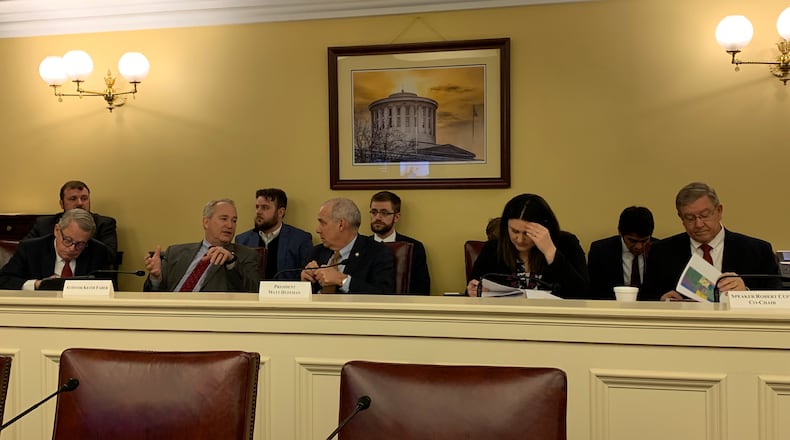State Sen. Vernon Sykes of Akron and House Minority Leader Allison Russo of Upper Arlington, the two Democrats on the seven-member commission, sought repeatedly over the past two weeks to schedule new meetings, as ordered by the court March 16 when justices threw out the district maps for the fourth time, again declaring that they unfairly favored Republicans.
It takes three members of the commission to call a meeting, or agreement of the co-chairs, Sykes and House Speaker Bob Cupp, D-Lima; on April 26, Auditor Keith Faber joined Sykes and Russo in seeking a meeting. Faber’s letter to other commissioners asked for “as soon as possible,” allowing remote participation for anyone who couldn’t attend in person.
He urged the commission to ask the Ohio Supreme Court for an extension to May 13, to set a “firm meeting schedule,” and to pick a redistricting plan (presumably one already in existence) as a starting point for amendments and review.
Since then the commission’s co-chairs have communicated through reciprocal letters, released to the media. The day after Faber’s letter, Sykes wrote to Cupp regarding Cupp’s proposal for a May 4 meeting.
“I accept the proposed date, but with reservations,” Sykes wrote. He endorsed allowing virtual participation, but said the commission needs more than two days to work on new maps. Sykes asked to rehire Douglas Johnson and Michael McDonald, independent experts hired previously at the supreme court’s suggestion.
Johnson and McDonald weren’t quite finished with their work on the afternoon of the last deadline, so Republican commissioners voted 4-3 to instead approve a slightly altered version of their third plan — which the court had already thrown out. Faber joined Democrats in dissent, predicting correctly that state justices would find that unacceptable.
Sykes wrote that extending the May 6 deadline to May 13 is “wholly unnecessary” — if the commission gets to work right away.
“You have also indicated in the press that your staff is already working on a General Assembly district plan and that you would make your map drawer available to Democratic commissioner staff in private meetings,” he wrote. “While I appreciate your offer to make staff available, the map drawing process should be done publicly and the commission should immediately retain the independent map drawers, Dr. Douglas Johnson and Dr. Michael McDonald, to allow for the finalization of their constitutional General Assembly district plan.”
Cupp replied in a letter on April 28, saying it would be “unwise and not feasible” to meet before May 4, due to the May 3 primary election. An earlier meeting would “further confuse the electorate,” Cupp wrote.
Sykes replied later on Thursday via email, reiterating his request to meet Friday, April 29. He said further that the commission should meet “every day until the court’s deadline.”
If no new maps are approved, or those maps are still under legal challenge as of May 28, Republicans would likely get what they want without further action: imposition of maps they already passed.
Separate from the months-long multi-party legal fight in the Ohio Supreme Court, a Republican-backed lawsuit, Gonidakis v. LaRose, asked a federal court to intervene. Two members of a three-judge federal panel initially declined, but on April 20 announced they would likely impose an existing set of maps if the state can’t settle the issue by May 28.
Plaintiffs note that inaction means the already-overturned third set of maps will probably be used in the eventual primary for state legislative seats.
In their repeated rejections of state legislative maps, state Supreme Court justices ordered a de facto reduction in Republican districts by insisting on a proportion of seats that met Ohio voters’ actual preferences in the last few elections. That breakdown is 54% Republican and 46% Democratic. Under the maps in place since 2012, Republicans hold a supermajority in both houses.
The rejected third set of maps would ostensibly create 54 Republican and 45 Democratic House seats, with 18 Republican and 15 Democratic Senate seats. But of those, 19 House and seven Senate seats would lean Democratic by less than 4%, while no Republican districts would be that close.
Other interested parties have weighed in. On April 25 the Ohio Unity Coalition, a group of black community institutions, sent commission members a letter urging “an end to the partisan games” and creation of fair and equal district maps.
The letter says the 2015 and 2018 constitutional amendments, which Ohioans overwhelmingly passed to create the current redistricting process, were intended to result in maps reflecting the state’s proportional partisan breakdown. It’s signed by more than 40 Black leaders from around the state, including some from the Miami Valley.
“Republican leaders on the commission have continually defied the orders of the Ohio Supreme Court, not to mention the will of the people of Ohio who’ve made their wishes understood in the two constitutional amendments that were passed,” they wrote. “This feels like the continuation of a national political scheme that is also playing out in other states to run out the clock and force unfair gerrymandered maps.”
About the Author

